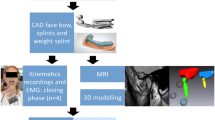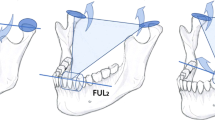Abstract
When jaw gape in unilateral biting or chewing narrows, the working/balancing side activity ratio (W/B ratio) of masseter muscles increases due to decrease of balancing side (BS) activity. This was interpreted as a neuromuscular strategy to delimit the impact of BS contacts during chewing. To test this hypothesis, we studied whether W/B ratios are associated with incidence of BS tooth contacts. In 40 healthy subjects, bilateral masseter activity was recorded during unilateral biting with different jaw gapes and during various chewing tasks. Biting was performed with absence and with deliberate avoidance or generation of BS tooth contacts. Subjects were divided into three groups according to jaw gapes of 2, 1, and 0.5 mm for which BS contact was first noticed in strong biting. The smaller this gape was, the higher were the mean W/B ratios. In biting with contact avoidance, the W/B ratios in each group increased with decreasing gape. In biting with generation of BS contacts, W/B ratios were smaller than with contact avoidance. W/B ratios in chewing with minimum interocclusal distances below 0.5 mm were bigger than in biting with contact generation and were mostly bigger than in biting with contact avoidance. The findings confirm that increasing the masseter W/B ratio is a neuromuscular measure suitable to avoid BS contacts and support the idea that motor control uses jaw gape-related activation to limit the impact of BS contacts. Clarification of this protection mechanism might contribute to uncover the etiology of functional disorders and occlusal malfunctions.



Similar content being viewed by others
References
Clark GT, Tsukiyama Y, Baba K, Watanabe T (1999) Sixty-eight years of experimental occlusal interference studies: what have we learned? J Prosthet Dent 82:704–713
Ramfjord SP (1961) Temporomandibular joint dysfunction. J Prosthet Dent 11:353–374
Belser UC, Hannam AG (1985) The influence of altered working-side occlusal guidance on masticatory muscles and related jaw movement. J Prosthet Dent 53:406–413
MacDonald JW, Hannam AG (1984) Relationship between occlusal contacts and jaw-closing muscle activity during tooth clenching: part I. J Prosthet Dent 52:718–729
MacDonald JW, Hannam AG (1984) Relationship between occlusal contacts and jaw-closing muscle activity during tooth clenching: part II. J Prosthet Dent 52:862–867
Van Eijden TMGJ, Blanksma NG, Brugman P (1993) Amplitude and timing of EMG activity in the human masseter muscle during selected motor tasks. J Dent Res 72:599–606
Nishigawa K, Nakano M, Bando E (1997) Study of jaw movement and masticatory muscle activity during unilateral chewing with and without balancing side molar contacts. J Oral Rehabil 24:691–696
Mizutani H, Shinogaya T, Xoneda K, Iso K, Ai M (1989) Influence of tooth contacts on masseter and temporal muscle activity. 1. Total activity and its ratio to maximum biting activity in intercuspal position (IP ratio). Nihon Hotetsu Shika Gakkai Zasshi 33:1062–1071
Anderson DJ, Picton DCA (1957) Tooth contact during chewing. J Dent Res 36:21–26
Ingervall B, Carlsson GE (1982) Masticatory muscle activity before and after elimination of balancing side occlusal interference. J Oral Rehabil 9:183–192
Woda A, Vigneron P, Kay D (1979) Nonfunctional and functional occlusal contacts: a review of the literature. J Prosthet Dent 42:335–341
Mohamed SE, Harrison JD, Christensen LV (1996) Masticatory tooth contact patterns: cuspid and first molar contacts during mastication of three types of food. J Craniomandib Pract 14:266–273
Ogawa T, Koyano K, Tsukiyama M, Tsukiyama Y, Sumiyoshi K, Suetsugu T (1998) Difference in the mechanism of balancing-side disclusion between 1st an 2nd molars. J Oral Rehabil 25:430–435
DeBoever JA, Carlsson GE, Klineberg IJ (2000) Need for occlusal therapy and prosthodontic treatment in the management of temporomandibular disorders. Part I. Occlusal interferences and occlusal adjustment. J Oral Rehabil 27:367–379
Mohamed SE, Christensen LV, Harrison JD (1983) Tooth contact patterns and contractile activity of the elevator jaw muscles during mastication of two different types of food. J Oral Rehabil 10:87–95
Agerberg G, Sandström R (1988) Frequency of occlusal interferences: a clinical study in teenagers and young adults. J Prosthet Dent 59:212–217
Seligman DA, Pullinger AG (1991) The role of functional occlusal relationships in temporomandibular disorders: a review. J Craniomandib Disord 5:265–279
Anderson DJ (1976) The incidence of tooth contacts in normal mastication and the part they play in guiding the final stage of mandibular closure. In: Anderson DJ, Mathews B (eds) Mastication. John Wright, Bristol
Lund JP (1991) Mastication and its control by the brain stem. Crit Rev Oral Biol Med 1:33–64
Lund JP, Kolta A (2006) Generation of the central masticatory pattern and its modification by sensory feedback. Dysphagia 21:167–174
Anderson K, Throckmorton GS, Buschang PH, Hayasaki H (2002) The effects of bolus hardness on masticatory kinematics. J Oral Rehabil 29:689–696
Morneburg TR, Proeschel PA (2003) In vivo forces on implants influenced by occlusal scheme and food consistency. Int J Prosthodont 16:481–486
Weijs WA (1980) Biomechanical models and the analysis of form: a study of the mammalian masticatory apparatus. Am Zool 20:707–719
Slagter AP, Bosman F, Van der Glas HW, Van der Bilt A (1993) Human jaw- elevator muscle activity and food comminution in the dentate and edentulous state. Arch Oral Biol 38:195–205
Möller E (1966) The chewing apparatus. Acta Physiol Scand 69(Suppl 280):1–229
Pröschel PA, Morneburg TR (2010) Indications for jaw gape-related control of relative muscle activation in sequent chewing strokes. J Oral Rehabil 37:178–184
Korioth TW, Hannam AG (1994) Deformation of the human mandible during simulated tooth clenching. J Dent Res 73:56–66
Baba K, Yugami K, Yaka T, Ai M (2001) Impact of balancing-side tooth contact on clenching induced mandibular displacements in humans. J Oral Rehabil 28:721–727
Okano N, Baba K, Ohyama T (2005) The influence of altered occlusal guidance on condylar displacement during submaximal clenching. J Oral Rehabil 32:714–719
Palla S, Gallo LM, Gossi D (2003) Dynamic stereometry of the temporomandibular joint. Orthod Craniofac Res 6(Suppl 1):37–47
Kuboki T, Azuma Y, Orsini MG, Takenami Y, Yamashita A (1996) Effects of sustained unilateral molar clenching on the temporomandibular joint space. Oral Surg Oral Med Oral Pathol Oral Radiol Endod 82:616–624
Pröschel PA, Morneburg TR (2002) Task-dependence of activity/bite-force relations and its impact on estimation of chewing force from EMG. J Dent Res 81:464–468
Türker KS (2002) Reflex control of human jaw muscles. Crit Rev Oral Biol Med 13:85–104
Lavigne G, Kim JS, Valiquette C, Lund JP (1987) Evidence that periodontal pressoreceptors provide positive feedback to jaw closing muscles during mastication. J Neurophysiol 58:342–358
Morimoto T, Inoue T, Masuda Y, Nagashima T (1989) Sensory components facilitating jaw-closing muscle activities in the rabbit. Exp Brain Res 76:424–440
Pröschel PA, Jamal T, Morneburg TR (2008) Motor control of jaw muscles in chewing and in isometric biting with graded narrowing of jaw gape. J Oral Rehabil 35:722–728
Kimoto K, Fushima K, Tamaki K, Toyoda M, Sato S, Uchimura N (2000) Asymmetry of masticatory muscle activity during the closing phase of mastication. J Craniomandib Pract 18:257–263
Jüch PJW, Minkels RF, van Willigen JD (1993) Inhibitory commissural connections of neurones in the trigeminal motor nucleus of the rat. Arch Oral Biol 38:1083–1091
Throckmorton GS, Ellis E 3rd, Hayasaki H (2003) Jaw kinematics during mastication after unilateral fractures of the mandibular condylar process. Am J Orthod Dentofacial Orthop 124:695–707
Mongini F, Tempia-Valenta G (1984) A graphic and statistical analysis of the chewing movements in fubction and dysfunction. J Craniomandib Pract 2:125–134
Ito T, Gibbs CH, Marguelles-Bonnet R, Lupkiewicz SM, Young HM, Lundeen HC, Mahan PE (1986) Loading of the temporomandibular joints with five occlusal conditions. J Prosthet Dent 56:478–484
Van der Bilt A, Ottenhoff FAM, van der Glas HM, Bosman F, Abbink JH (1997) Modulation of the mandibular stretch reflex sensitivity during various phases of rhythmic open-close movements in humans. J Dent Res 76:839–847
Lobbezoo F, Sowman PF, Türker KS (2009) Modulation of human exteroceptive jaw reflexes during simulated mastication. Clin Neurophysiol 120:398–406
Mostafeezur RM, Yamamura K, Kurose M, Yamada Y (2009) Mastication- induced modulation of the jaw-opening reflex during different periods of mastication in awake rabbits. Brain Res 1254:28–37
Naser-ud-Din S, Sowman PF, Dang H, Türker KS (2010) Modulation of masseteric reflexes by simulated mastication. J Dent Res 89:61–65
Appenteng K, Lund JP, Seguin JJ (1982) Intraoral mechanoreceptor activity during jaw movement in the anaesthetized rabbit. J Neurophysiol 48:27–37
Cadden SW, Newton JP (1988) A comparison of reflex depressions of activity in jaw-closing muscles evoked by intra and peri-oral stimuli in man. Arch Oral Biol 33:863–869
Hück NL, Abbink JH, Hoogenkamp E, van der Bilt A, van der Glas HW (2005) Exteroceptive reflexes in jaw-closing muscle EMG during rhythmic jaw closing and clencing. Exp Brain Res 162:230–238
Stohler CS, Ash MM (1984) Silent period in jaw elevator muscle activity during mastication. J Prosthet Dent 52:729–735
Owall B, Elmqvist D (1975) Motor pauses in EMG activity during chewing and biting. Odontol Revy 26:17–38
Trulsson M, Johansson RS (1996) Encoding of tooth loads by human periodontal afferents and their role in jaw motor control. Prog Neurobiol 49:267–284
Müller F, Heath MR, Kazazoglu E, Hector MP (1993) Contribution of periodontal receptors and food qualities to masseter muscle inhibition in man. J Oral Rehabil 20:281–290
Hatcher DC, Faulkner MG, Hay A (1986) Development of mechanical and mathematical models to study temporomandibular joint loading. J Prosthet Dent 55:377–384
Lobbezoo F, Zwijnenburg AJ, Naeije M (2000) Functional subdivision of the human masseter and temporalis muscles as shown by the condylar movement response to electrical muscle stimulation. J Oral Rehabil 27:887–892
Schindler HJ, Rues S, Türp JC, Schweizerhof K, Lenz J (2005) Activity patterns of the masticatory muscles during feedback-controlled simulated clenching activities. Eur J Oral Sci 113:469–478
Fushima K, Gallo LM, Krebs M, Palla S (2003) Analysis of the TMJ intraarticular space variation: a non-invasive insight during mastication. Med Eng Phys 25:181–190
Acknowledgments
The authors thankfully like to acknowledge that this work was supported by the Wilhelm Sander Foundation, grant no. 2003.009.1
Conflict of interest
The authors declare that they have no conflict of interest.
Author information
Authors and Affiliations
Corresponding author
Rights and permissions
About this article
Cite this article
Schubert, D., Pröschel, P., Schwarz, C. et al. Neuromuscular control of balancing side contacts in unilateral biting and chewing. Clin Oral Invest 16, 421–428 (2012). https://doi.org/10.1007/s00784-011-0542-y
Received:
Accepted:
Published:
Issue Date:
DOI: https://doi.org/10.1007/s00784-011-0542-y




